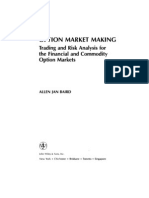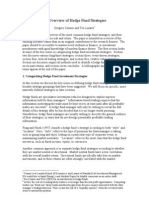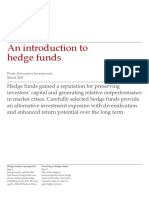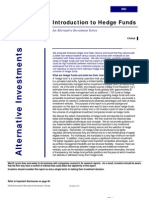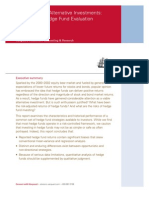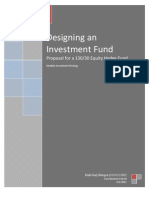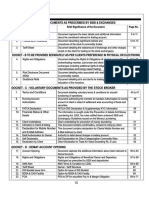Hedgeing Benefits
Hedgeing Benefits
Uploaded by
priya_sondhiCopyright:
Available Formats
Hedgeing Benefits
Hedgeing Benefits
Uploaded by
priya_sondhiCopyright
Available Formats
Share this document
Did you find this document useful?
Is this content inappropriate?
Copyright:
Available Formats
Hedgeing Benefits
Hedgeing Benefits
Uploaded by
priya_sondhiCopyright:
Available Formats
Center for International Securities and Derivatives Markets
The Benefits of Hedge Funds
March 2003
Prepared by: Alper Daglioglu, Research Associate Georgi Georgiev, Research Associate Bhaswar Gupta, Research Associate
CISDM/University of Massachusetts, Amherst Massachusetts, 01003 Ph: 413-545-5641; Fax: 413-545-3858 Email: CISDM@som.umass.edu WEB Page: www.cisdm.org
Center for International Securities and Derivatives Markets
The Benefits of Hedge Funds
Introduction The alternative investment universe consists of a number of investment strategies that offer risk and return opportunities not commonly found in traditional long only stock and bond investment. A natural way to differentiate between different alternative investment strategies is to examine the liquidity of the investment vehicle. The most illiquid are investment trusts such as venture capital funds, leverage buyout funds and natural resource partnerships that do not, as a general rule, allow selective redemptions. Hedge funds are moderately liquid alternative investments. Hedge funds likewise manage client assets on a discretionary basis and generally represent 'leveraged' investment strategies that use global cash as well as global futures and options markets. This article focuses on the academic evidence on the benefits of adding hedge funds to an investment portfolio. Hedge funds trade in both cash and derivative markets, and can provide returns based not only on market direction but also unique return opportunities available in individual markets and securities. However, for hedge funds to continue to grow as an investment alternative, individuals need to increase their knowledge and comfort level as to their use in investment portfolios. Exactly, what are the benefits of hedge funds as part of an investors overall asset portfolio? While, it is impossible in a short synopsis to convey all the details of the benefits of hedge funds, hedge funds offer the opportunity to: (1) reduce portfolio volatility risk, (2) enhance portfolio returns in economic environments in which traditional stock and bond investments offer limited opportunities, and (3) participate in a wide variety of new financial products and markets not available in traditional investor products. General Description of Hedge Funds Hedge funds have been described as skill-based investment strategies. Skill-based strategies obtain returns from the unique skill or strategy of the trader. As a result, hedge funds have also been described as absolute return strategies, as these returns do not depend on the long-term return in underlying traditional stock and bond markets. Because hedge funds are actively managed, trader skill is certainly important, as are the basic trading strategies behind most hedge fund investments. However, more recently, hedge fund returns have been shown to be driven largely by market factors such as changes in credit spreads or market volatility, so one can think of their returns as a combination of manager skill and an underlying return to the strategy itself. With the increased use of hedge fund vehicles in investment management, industry practitioners and academics have created return series for hedge fund strategies that can be used as benchmarks for hedge fund investors. Investors should note that each hedge fund return series has its own approach to performance presentation, manager selection, and investment style
Center for International Securities and Derivatives Markets
classification. In this article we use primarily the hedge fund indices compiled by Evaluation Associates Capital Markets (EACM). A short description of the EACM classification follows: Hedge Fund Performance Series Hedge funds are often classified according to investment style (for example, relative value). Within each style category, funds are then classified according to the underlying markets traded. For example, within the relative value style classification, there are a number of sub-groups, including long/short equity, convertible hedging, and bond hedging. EACM classifies hedge funds into the following categories. (1) Relative Value: Balanced, or hedged, long and short positions with subindices such Market Neutral or Long/Short equity (long undervalued equities/short overvalued equities usually on an equal dollar bases); Convertible hedging (long convertible bonds or preferred, short underlying common); Bond hedging (yield curve arbitrage or long/short debt positions); Rotational (multiple relative value strategies, including all of the above). (2) Event Driven: (Corporate transactions and special situations) subindices including Deal Arbitrage (long/short equity securities of companies involved in corporate transactions; Bankruptcy/Distressed (long undervalued securities of companies usually in financial distress or operating under Chapter 11). Multi-strategy includes deal funds dealing in both deal arbitrage and bankruptcy. (3) Equity Hedge Funds: Long and short securities with varying degrees of exposure and leverage such as Domestic Long Equity (long undervalued US equities; short selling is used sparingly); Domestic Opportunistic Equity/Long short Equity (long and short U.S. equity with ability to be net short overall) and Global International (primarily long undervalued equities with the ability to use short selling opportunistically) (4) Global Asset Allocators: Opportunistically long and short multiple financial and/or nonfinancial assets. Sub-indices include Systematic (long or short markets based on trendfollowing or other quantitative analysis) and Discretionary (long or short markets based on qualitative/fundamental analysis often with technical input) (5) Short Selling: Short sale of U.S. equities with expectation of price declines. In addition to EACM, other firms that provide active hedge fund manager returns, such as HFR and CSFB/Tremont provide similar groupings as well as additional subset groupings. Empirical results in this paper are presented using the EACM hedge fund returns, however, results are similar using other hedge fund reporting services (results available from authors on request).
Center for International Securities and Derivatives Markets
The Growth and Benefit of Alternative Investments Investment firms have always followed proprietary trading strategies involving both cash market and derivative positions. More recently, institutional investors such as corporate and public pension funds, endowments and trusts, and bank trust departments have been including hedge funds as one segment of a well-diversified portfolio. Growth in investor demand for hedge fund products indicates investor appreciation of the potential benefits of trading in derivatives markets. There are also a number of advantages that derivatives markets have over cash markets, including lower transaction costs, lower market impact costs, and inexpensive access to leverage. In addition, certain trading strategies that rely primarily on exchange-traded derivatives offer the additional benefits of market integrity, safety, and government oversight. Hedge Funds: Risk and Return Performance Results in Exhibit 1 show the performance of a number of assets and combinations of assets (traditional assets and hedge funds) over the past twelve years (1990-2002).1 These assets include the EACM 100 index and several measures of U.S. and global stock and bond performance. The EACM 100 index has a higher Sharpe ratio than any of the other assets.2 The benefit of including hedge funds in diversified portfolios is illustrated in Exhibit 2. When the hedge fund index (EACM 100) is added to the U.S. stocks, Treasury Bonds, or a portfolio of U.S. stocks and bonds, the risk/return profile improves. Exhibit1
Performance: January 1990 - December 2002 EACM 100 Annualized Return Annualized Standard Deviation Sharpe Ratio Minimum Monthly Return Correlation With EACM 100 12.83% 4.28% 1.88 -4.45% 1.00 Portfolio I S&P 500 & Lehman Bond S&P 500 9.68% 15.28% 0.32 -14.46% 0.41 Portfolio II S&P 500, Lehman Bond and EACM 100 10.05% 7.00% 0.75 -5.89% Lehman Gov./Corp. Bond 8.30% 4.25% 0.83 -2.45% 0.15 Portfolio III MSCI and Lehman Bond MSCI 4.20% 15.08% -0.04 -13.35% 0.41 Portfolio IV MSCI, Lehman Bond and EACM 100 7.55% 7.11% 0.39 -5.39% Lehman Global Bond 7.65% 5.03% 0.57 -2.97% 0.04
Annualized Return Annualized Standard Deviation Sharpe Ratio Minimum Monthly Return Correlation with EACM 100
9.30% 8.25% 0.55 -6.25% 0.42
6.21% 8.43% 0.17 -5.63% 0.37
Portfolio I = 50% S&P 500 and 50% Lehman Brothers Gov./Corp. Bond Portfolio II = 40% S&P 500, 40% Lehman Brothers Gov./Corp. Bond and 20% EACM 100 Portfolio III = 50% MSCI and 50% Lehman Brothers Global Bond Portfolio IV = 40% MSCI, 40% Lehman Brothers Global Bond and 20% EACM 100 EACM 100 = Index of Hedge Fund Strategies
Source: EACM, Datastream
1 The annual and monthly returns presented in their nominal form. Annualized standard deviations are derived by multiplying the monthly data by the square root of 12. 2 In this study, Portfolio I is a portfolio comprised of the S&P500 (50%), and Lehman Brothers Bond Indices (50%), Portfolio II is a portfolio comprised of EACM 100 (20%), S&P500 (40%), and Lehman Brothers Bond (40%). Portfolio III and IV are similar to Portfolios I and II with the substitution of the MSCI World Equity and Lehman Brothers Global Bond Index for the S&P 500 and Lehman Brothers Bond Index, respectively.
Center for International Securities and Derivatives Markets
Exhibit 2
Risk and Return of Stock, Bond and Hedge Funds: January 1990-December 2002
14.00% 100% EACM 100 12.00% 10.00% 8.00% 6.00% 4.00% 2.00% 0.00% 0.00% 100% Lehman Bond 50% S&P 500 and 50% Lehman Bond 100% S&P 500
Portfolio Annualized Return
2.00%
4.00%
6.00%
8.00%
10.00%
12.00%
14.00%
16.00%
18.00%
Portfolio Annualized Standard Deviation
Risk/Return Opportunities for Hedge Fund Subindices Results in Exhibit 1 and 2 show the performance of the EACM 100 index. The actual performance of EACM subindices could differ from that of the overall hedge fund index performance. The risk and return benefit of a wide range of hedge fund indices and subindices as well as their correlations with the traditional indices are given in Exhibit 3 and Exhibit 4. Exhibit 3
Performance: EACM Hedge Fund Strategies, CISDM CTA Index and Traditional Assets (January 1990-December 2002) Annual Return EACM100 Relative Value Event Driven Equity Hedge Global Asset Allocators CISDM CTA $ Weighted S&P 500 Lehman Bond Index 12.83% 9.74% 12.02% 14.99% 16.04% 11.19% 9.68% 8.30% Standard Deviation 4.28% 3.33% 5.11% 10.47% 9.98% 10.14% 15.28% 4.25% Sharpe Ratio 1.88 1.49 1.42 0.98 1.13 0.63 0.32 0.83 Minimum Monthly Return -4.45% -6.07% -7.48% -9.81% -5.38% -6.00% -14.46% -2.45% Correlation with S&P 500 0.41 0.12 0.49 0.62 0.07 -0.13 1.00 0.16 Correlation with Lehman Bond Index 0.15 -0.04 0.06 0.07 0.25 0.28 0.16 1.00
Source: EACM, Datastream
Center for International Securities and Derivatives Markets
Exhibit 4
Performance: EACM Hedge Fund Strategies and Traditional Assets (January 1990-December 2002) Return Relative Value Market Neutral Convertible Hedge Bond Hedge Rotational Event Driven Arbitrage Bankruptcy Multi-Strategy Equity Hedge Domestic Long Long/Short Global/International Global Asset Allocators Discretionary Systematic Short Selling S&P 500 Lehman Bond Index Standard Deviation 3.21% 5.27% 4.78% 6.35% 6.06% 6.43% 5.26% 15.41% 10.03% 10.94% 9.19% 16.20% 22.11% 15.28% 4.25% Sharpe Ratio 1.16 0.95 0.32 1.49 0.63 1.35 1.75 0.50 1.13 0.99 1.01 0.77 -0.14 0.32 0.83 Minimum Monthly Return -2.62% -6.90% -7.09% -13.98% -11.10% -8.17% -8.29% -15.11% -5.15% -9.17% -15.87% -9.85% -12.99% -14.46% -2.45% Correlation with S&P 500 -0.17 0.17 0.18 0.07 0.49 0.34 0.46 0.69 0.24 0.60 0.33 -0.10 -0.78 1.00 0.16 Correlation with Lehman Bond 0.18 0.04 -0.10 -0.14 0.11 0.02 0.03 0.07 -0.01 0.11 0.08 0.26 -0.06 0.16 1.00
8.50% 9.76% 6.30% 14.23% 8.56% 13.48% 13.94% 12.53% 16.11% 15.63% 14.07% 17.21% 1.75% 9.68% 8.30%
Source: EACM, Datastream
However, the actual performance of certain subindices is dependent on the unique market conditions in traditional markets. As shown in Exhibit 5, hedge fund indices with exposure to market factors such as the return of the stock and bond market or stock market volatility may not necessarily provide diversification relative to traditional stock and bond market returns especially in periods of high market uncertainty. For instance, while the relative value has a low correlation with the S&P 500 and the change on the S&P 500 volatility, the equity hedge is positively correlated with the S&P500 while negatively correlated with the change on the S&P 500 volatility. It is also interesting to point out that systematic trading advisors (e.g., managed futures) have a positive correlation with the change on the S&P 500 volatility.3 The different sensitivity of various hedge fund strategies to various market factors results in different correlations among hedge fund strategies themselves. The correlations between various hedge fund strategies are given in Exhibit 6.
While some research (Schneeweis and Pescatore ed., 1999) has focused on Commodity Trading Advisors (CTAs) as offering exposure to long volatility, unless specifically designed to capture volatility, systematic CTA strategies often make returns in periods of low volatility high trend markets. Systematic commodity trading programs (e.g., CTAs) are positively correlated with various passive trend-following indices. See The Benefits of Managed Futures (CISDM, University of Massachusetts, 2002) and www.cisdm.org for information. In Exhibit 5, credit spread is the yield on the Moodys Baa corporate bond yield less the yield on the Moodys Aaa corporate bond yield; the term spread is the 10 year government yield less the one year T-bill yield; the VIX is the implied volatility on the S&P100 (weighted average of the at the money). Stock and bond volatility is measured as monthly volatility using daily returns on the S&P 500 and Lehman Brothers bond indices.
Center for International Securities and Derivatives Markets
Exhibit 5
Factor Correlations (January 1990-December 2002) S&P 500 Lehman Bond Index 0.15 -0.04 0.06 0.07 0.25 0.28 0.16 1.00 Change in Credit Spread (Baa-Aaa) -0.22 -0.24 -0.28 -0.20 -0.02 0.01 -0.14 -0.07 Change in VIX Change in Term Spread Change in Bond Volatility -0.17 -0.17 -0.12 -0.06 -0.13 -0.13 0.01 -0.09 Change in Stock Volatility -0.32 -0.14 -0.40 -0.33 -0.11 -0.04 -0.28 -0.04
EACM100 Relative Value Event Equity Hedge Global Asset Allocators CISDM CTA $ Weighted S&P 500 Lehman Bond Index
0.41 0.12 0.49 0.62 0.07 -0.13 1.00 0.16
-0.23 -0.01 -0.44 -0.41 0.00 0.21 -0.68 0.02
-0.06 0.11 0.02 -0.02 -0.10 -0.17 0.01 -0.55
Exhibit 6
Correlations (January 1990-December 2002) EACM 100 1.00 0.51 0.53 0.80 0.62 0.41 0.15 0.41 0.04 Relative Value 1.00 0.45 0.27 0.08 0.12 -0.04 0.16 -0.14 Event Driven Equity Hedge Global AA S&P500 Lehman Bond MSCI World Lehman Glob. Bond
EACM100 Relative Value Event Driven Equity Hedge Global Asset Allocators S&P500 Lehman Bond MSCI World Lehman Global Bond
1.00 0.54 0.01 0.49 0.06 0.43 -0.08
1.00 0.16 0.62 0.07 0.61 0.00
1.00 0.07 0.25 0.03 0.20
1.00 0.16 0.86 0.10
1.00 0.11 0.73
1.00 0.21
1.00
Source: EACM, Datastream
Multi-Manager Hedge Fund Portfolios: Nave and Planned Asset Allocation Modern portfolio theory points out that the true measure of risk for investors is the expected standard deviation of a portfolio of investments. Past research has shown that an equallyweighted diversified portfolio of 8 to10 randomly selected equity securities will result in a portfolio standard deviation similar to that of the investment population from which it is drawn. Similarly, for hedge funds, Henker [1998] show that a randomly selected, equal-weighted portfolio of 8-10 hedge funds has a standard deviation similar to that of the population from which it is drawn. Thus, as is true for equity portfolios, multi-manager hedge fund portfolios may have risk levels similar to that of a larger population of hedge funds. As important, a portfolio of randomly selected hedge funds has a correlation in excess of 0.90 with that of a typical hedge fund benchmark. Thus, the use of a smaller subset of hedge funds can represent the performance of the EACM 100 hedge fund index, just as a smaller portfolio of stocks or mutual funds can represent, respectively, the performance of the S&P 500 or mutual fund indices. Actual investment with alternative investments (e.g., hedge funds), however, requires investors to determine the actual level of investment within the alternative investment universe as well as between alternative investments and traditional investments. As shown in Exhibit 7, as the investor moves from high return and risk tradeoff to lower return and risk tradeoff the amount of investment into more market neutral investments (e.g., long/short equity or global asset allocators) increases.
6
Center for International Securities and Derivatives Markets
Exhibit 7
Source: Datastream
Center for International Securities and Derivatives Markets
Risk/Return Opportunities in Periods of Market Underperformance/Overperformance
The correlation between alternative investments and most traditional investments are close to zero (Exhibit 5). However, when asset returns are segmented according to whether the traditional asset increased or decreased in value, certain hedge funds are often negatively correlated in months when traditional asset returns are negative while being positively correlated when traditional asset returns are positive. For instance, as shown in Exhibit 8 and Exhibit 9, for the period 1990 through 2002, commodity trading advisors are negatively correlated (-0.36) with the S&P 500 when with the S&P 500 posted its forty-eight worst months and yet are positively correlated (0.11) when the S&P 500 reported its best forty-eight months. In contrast, certain hedge funds (e.g., equity hedge) have low correlation with the S&P 500 when it is rising and high correlation with the S&P 500 when it is falling. Thus the benefits of hedge funds with equity or credit exposure may arise less from their diversification advantages with equity-based portfolios than from their higher expected return/risk tradeoffs.
Exhibit 8
Correlations in Best and Worst Forty-Eight S&P 500 Ranked Months (January 1990-December 2002) All S&P Months 0.12 0.49 0.62 0.07 -0.13 Worst S&P 500 Forty-Eight Months 0.59 0.62 0.54 -0.01 -0.36 Best S&P 500 Forty-Eight Months -0.12 -0.21 0.00 0.09 0.11
Relative Value Event Driven Equity Hedge Global Asset Allocators CTA $ Weighted Index
Source: EACM, Datastream
Exhibit 9
Correlations in Best and Worst Forty-Eight S&P 500 Ranked Months (January 1990-December 2002)
CISDM CTA $ Weighted 0.15 0.10 0.05 Equity Hedge -0.60 -0.40 -0.20 0.00 0.00 -0.05 -0.10 -0.15 -0.20 -0.25 Event Driven 0.20 0.40 Relative Value 0.60 0.80 Global Asset Allocators
Correlation in Forty-Eight Best S&P 500 Months
Correlation in Forty-Eight Worst S&P 500 Months
Center for International Securities and Derivatives Markets
Recent Performance (1998-2002)
The benefits of adding hedge funds to a diversified portfolio may, however, are affected by the historical high returns achieved by hedge funds in the first half of the 1990's. In Exhibit 11, the return and risk frontier of adding the EACM 100 to the S&P 500 and Lehman Govt./Corp. Bond index portfolio is given for the recent five year period, 1998-2002. As shown in Exhibit 10, in the period 1998-2002, the return of the EACM 100 was lower and the risk was higher than for the full period 1990-2002.4
Exhibit 10
Performance: January 1998 - December 2002 EACM 100 Annualized Return Annualized Standard Deviation Sharpe Ratio Minimum Monthly Return Correlation with EACM 100 7.33% 5.12% 0.61 -4.45% 1.00 Portfolio I S&P 500 & Lehman Bond S&P 500 -0.59% 18.91% -0.25 -14.46% 0.45 Portfolio II S&P 500, Lehman Bond and EACM 100 4.70% 7.75% 0.06 -5.89% 0.55 Lehman Gov./Corp. Bond 7.62% 3.91% 0.87 -2.38% -0.12 Portfolio III MSCI and Lehman Bond MSCI -2.11% 17.41% -0.36 -13.35% 0.53 Portfolio IV MSCI, Lehman Bond and EACM 100 3.22% 7.61% -0.13 -5.39% 0.58 Lehman Global Bond 5.66% 5.49% 0.27 -2.97% -0.16
Annualized Return Annualized Standard Deviation Sharpe Ratio Minimum Monthly Return Correlation With EACM 100
3.98% 9.05% -0.02 -6.25% 0.45
2.16% 8.84% -0.23 -5.63% 0.47
Portfolio I = 50% S&P 500 and 50% Lehman Brothers Gov./Corp. Bond Portfolio II = 40% S&P 500, 40% Lehman Brothers Gov./Corp. Bond and 20% EACM 100 Portfolio III = 50% MSCI and 50% Lehman Brothers Global Bond Portfolio IV = 40% MSCI, 40% Lehman Brothers Global Bond and 20% EACM 100 EACM 100 = Index of Hedge Fund Strategies
Source: EACM, Datastream
Exhibit 11
Risk and Return of Stock, Bond and Hedge Funds: January 1998-December 2002
8.00% 7.00% 6.00% 5.00% 4.00% 3.00% 2.00% 1.00% 0.00% 0.00% 100% S&P 500 50% S&P 500 and 50% Lehman Bond 100% EACM 100 100% Lehman Bond
Portfolio Annualized Return
2.00%
4.00%
6.00%
8.00%
10.00%
12.00%
14.00%
16.00%
18.00%
20.00%
Portfolio Annualized Standard Deviation
4 Similar improvements in the return/risk frontier result from using the CISDM $ Weighted CTA index. See Benefits of Managed Futures, CISDM, University of Massachusetts, 2002.
Center for International Securities and Derivatives Markets
Comparison of Traditional and Alternative Investment Vehicles
While alternative and traditional investment may differ in terms of their strategies and investment goals, there is very little difference in the methods of structuring and packaging the returns. For instance, in the hedge fund area, as in the traditional asset area, investors can obtain 1) an active investment index reflecting the expected return of a particular investment strategy or 2) open and closed-end funds that track a particular investment strategy offered by managers. These open and closed end funds may be single or multiple-manager in form, private pool/limited partnerships and segregated accounts (private investment trusts). Many new alternative investment products have also been developed to assuage investor concerns. For example, guaranteed investment structures remain a principal source of investment offerings. These products eliminate or minimize the risk of loss of principal if held to maturity. Guaranteed products have a lower return than direct investment in the underlying fund. Many alternative investments are not materially different from traditional stock and bond investments in terms of market structure, product structure, or security design. Stock and bond investments share many common features with alternative assets. These features include institutional issues such as government regulation and professional oversight. While some hedge funds trade primarily on relatively unregulated over-the-counter markets, most hedge funds and commodity trading advisors trade on regulated exchanges such as the New York Mercantile Exchange or the Chicago Board of Trade in which financial products are traded in real-time liquid markets. Investors must appreciate that the essential difference between alternative and traditional investments is not how they are governed, marketed or even measured in terms of market performance, but that alternative investments offer unique risk and return properties not easily available though traditional investment securities or investment products. These return opportunities stem from the expanded universe of securities available to trade and the strategies that can be employed. Funds can access both financial and nonfinancial (commodity) markets and can easily take, long, short, spread, and option positions in any of these markets. Expanding the set of investment opportunities results in providing diversification benefits to a portfolio that cannot be replicated through traditional stock, bond, and real estate investment strategies.
Summary and Conclusion
For alternative investments such as hedge funds to grow as an investment alternative, individuals need to increase their knowledge and comfort level as to their use in investment portfolios The logical extension of using investment managers with specialized knowledge of traditional markets to obtain maximum return/risk tradeoffs is to add specialized managers who can obtain the unique returns in market conditions and types of securities not generally available to traditional asset managers; that is, hedge funds. In addition, investors must compare the unique returns available to each of the hedge fund styles to insure that the particular style does not duplicate existing investment opportunities.
10
Center for International Securities and Derivatives Markets
Bibliography
Schneeweis, Thomas. "Dealing with Myths of Hedge Funds," The Journal of Alternative Investments (Winter, 1998), pp.11-15. Schneeweis, Thomas and Joe Pescatore eds. The Handbook of Alternative Investment Strategies: An Investor's Guide. Institutional Investor, 1999.
11
You might also like
- Baird - Option Market Making, 1993Document205 pagesBaird - Option Market Making, 1993ethexman80% (5)
- Ultimate Trading HandbookDocument140 pagesUltimate Trading HandbookJameson PowersNo ratings yet
- External Hedging Techniques For Managing Foreign Exchange RiskDocument7 pagesExternal Hedging Techniques For Managing Foreign Exchange RiskTanmay Mehta0% (2)
- Financial Management Term PaperDocument29 pagesFinancial Management Term PaperOmar Faruk50% (2)
- An Overview of Hedge Fund StrategiesDocument23 pagesAn Overview of Hedge Fund StrategiesrlindseyNo ratings yet
- Global Equity MarketsDocument20 pagesGlobal Equity MarketsMohsin JavedNo ratings yet
- An Introduction To Hedge Fund StrategiesDocument44 pagesAn Introduction To Hedge Fund StrategiesAdnan Perwaiz0% (1)
- Lesson # 22 Common Stock: Analysis and Strategy The Passive StrategyDocument3 pagesLesson # 22 Common Stock: Analysis and Strategy The Passive StrategyRajesh KumarNo ratings yet
- An Introduction To Hedge Funds: Pictet Alternative InvestmentsDocument16 pagesAn Introduction To Hedge Funds: Pictet Alternative InvestmentsGauravMunjalNo ratings yet
- DocumentDocument24 pagesDocumentKavita PawarNo ratings yet
- Unconfirmed 205358.crdownloadDocument13 pagesUnconfirmed 205358.crdownloadKavita PawarNo ratings yet
- Hritwik Das c-203 m-1 Roll-19Document7 pagesHritwik Das c-203 m-1 Roll-19Kashfa NaserNo ratings yet
- Term Paper Investment AnalysisDocument5 pagesTerm Paper Investment AnalysisFaisal KarimNo ratings yet
- 57043bos46238cp5 PDFDocument82 pages57043bos46238cp5 PDFVatsal TikiwalaNo ratings yet
- Mutual Fund Performance - An Empirical StudyDocument10 pagesMutual Fund Performance - An Empirical StudyAmeya ThakurNo ratings yet
- Hedge Fund 220605 MLDocument40 pagesHedge Fund 220605 MLMozzam RangwalaNo ratings yet
- Hedge Funds - in Emerging MarketsDocument75 pagesHedge Funds - in Emerging MarketsDipesh JainNo ratings yet
- 46370bosfinal p2 cp6 PDFDocument85 pages46370bosfinal p2 cp6 PDFgouri khanduallNo ratings yet
- A Guide To Hedge Funds PDFDocument39 pagesA Guide To Hedge Funds PDFman downNo ratings yet
- Financial Analysis On Mutual Fund Schemes With Special Reference To SBI Mutual Fund CoimbatoreDocument6 pagesFinancial Analysis On Mutual Fund Schemes With Special Reference To SBI Mutual Fund CoimbatoreCheruv SoniyaNo ratings yet
- Hedge Funds ProjectDocument8 pagesHedge Funds ProjectAyesha PattnaikNo ratings yet
- Hedge & Abs Return Strategies-Commonfund-+++Document8 pagesHedge & Abs Return Strategies-Commonfund-+++fcvahibNo ratings yet
- Hedge Funds - Free Guide #006Document11 pagesHedge Funds - Free Guide #006katrams010No ratings yet
- Building A Global Core-Satellite Portfolio: Executive SummaryDocument12 pagesBuilding A Global Core-Satellite Portfolio: Executive SummarydospxNo ratings yet
- An Overview of Hedge Fund Strategies:, IncludingDocument24 pagesAn Overview of Hedge Fund Strategies:, IncludingSanta's StoogeNo ratings yet
- What Is Diversification?Document4 pagesWhat Is Diversification?Jonhmark AniñonNo ratings yet
- Financial Institutions and MarketsDocument13 pagesFinancial Institutions and MarketsVinita SinghNo ratings yet
- Assignment On Investment Analysis & Portfolio ManagementDocument10 pagesAssignment On Investment Analysis & Portfolio Managementchondonsaha143No ratings yet
- Imbalances Created Because of Structured Products in India Equity MarketsDocument8 pagesImbalances Created Because of Structured Products in India Equity MarketsManmohan BhartiaNo ratings yet
- Hedge Fund Primer Vanguard)Document24 pagesHedge Fund Primer Vanguard)Lee BellNo ratings yet
- Mutual Fund Prot and DivDocument13 pagesMutual Fund Prot and Divbharatt25No ratings yet
- ConclusionDocument4 pagesConclusionSatbir Ratti33% (3)
- Portfolio Construction Using Sharpe Index Model With Special Reference To Pharmaceutical, Banking, Construction, FMCG, and Oil&Gas SectorsDocument20 pagesPortfolio Construction Using Sharpe Index Model With Special Reference To Pharmaceutical, Banking, Construction, FMCG, and Oil&Gas SectorsHari VijayaNo ratings yet
- AARM CAIA Benchmarks-1Document12 pagesAARM CAIA Benchmarks-1alainvaloisNo ratings yet
- 83283bos67342-cp6 (1)Document130 pages83283bos67342-cp6 (1)thanyacainterNo ratings yet
- Hedge Funds Presentation Apr 08Document31 pagesHedge Funds Presentation Apr 08Marina BoldinaNo ratings yet
- Full - Text On Investment StrategiesDocument23 pagesFull - Text On Investment StrategiesLogesh MohanNo ratings yet
- Creating and Monitoring A Diversified Stock PortfolioDocument11 pagesCreating and Monitoring A Diversified Stock Portfolioసతీష్ మండవNo ratings yet
- Mutual Funds DescriptionDocument2 pagesMutual Funds DescriptionJash JainNo ratings yet
- Alternative Investment Lecture-17 Managed Futures May 29Document12 pagesAlternative Investment Lecture-17 Managed Futures May 29MD TANVIR HASANNo ratings yet
- Designing An Investment Fund: Proposal For A 130/30 Equity Hedge FundDocument22 pagesDesigning An Investment Fund: Proposal For A 130/30 Equity Hedge FundrishirajdhingraNo ratings yet
- A Research Proposal FOR Grand Project ON Perrformance Evaluation of Mutual Fund Submitted ToDocument11 pagesA Research Proposal FOR Grand Project ON Perrformance Evaluation of Mutual Fund Submitted TokkrathodNo ratings yet
- CH 16Document9 pagesCH 16NMBGolfer100% (1)
- Mutual Fund - A Study of Investor's Awareness and Performance of Equity Diversified Mutual Fund Schemes in INDIADocument25 pagesMutual Fund - A Study of Investor's Awareness and Performance of Equity Diversified Mutual Fund Schemes in INDIAaamritaaNo ratings yet
- Portfolio Investment ProcessDocument6 pagesPortfolio Investment ProcessmayurroyalssNo ratings yet
- 00 An Introduction To Investment DBA Portfolio Theory Winter23Document13 pages00 An Introduction To Investment DBA Portfolio Theory Winter23Ayman MoussaNo ratings yet
- Graham CapitalDocument49 pagesGraham CapitalDave JohnsonNo ratings yet
- Managing Bond PortfoliosDocument11 pagesManaging Bond PortfoliosLucela InocNo ratings yet
- Simon Business SchoolDocument4 pagesSimon Business SchoolYuvraj ChauhanNo ratings yet
- Ijrpr2855 A Study of Diversification Application in Portfolio ManagementDocument9 pagesIjrpr2855 A Study of Diversification Application in Portfolio ManagementAryabhatt ThakurNo ratings yet
- Unit V , VI AND VIII Concepts of Portfolio Management & Portfolio TheoriesDocument36 pagesUnit V , VI AND VIII Concepts of Portfolio Management & Portfolio TheoriesArihant JainNo ratings yet
- Portfolio MGTDocument98 pagesPortfolio MGTNishantNo ratings yet
- Risk Measurement PDFDocument52 pagesRisk Measurement PDFalfredo_lmpNo ratings yet
- Chap 005Document7 pagesChap 005Han giaNo ratings yet
- CVaR Vs CDaRDocument25 pagesCVaR Vs CDaRcuenta 2No ratings yet
- Moduel 4Document4 pagesModuel 4sarojkumardasbsetNo ratings yet
- Steps of Portfolio Management Process /steps of Portfolio ManagementDocument8 pagesSteps of Portfolio Management Process /steps of Portfolio ManagementRuchi KapoorNo ratings yet
- Risk MeasurementDocument52 pagesRisk MeasurementBhaskkar SinhaNo ratings yet
- Chapter 2Document10 pagesChapter 2Lasborn DubeNo ratings yet
- Article PMDocument9 pagesArticle PMferoz khanNo ratings yet
- An easy approach to common investment funds: The introductory guide to mutual funds and the most effective investment strategies in the field of asset managementFrom EverandAn easy approach to common investment funds: The introductory guide to mutual funds and the most effective investment strategies in the field of asset managementNo ratings yet
- Technical Event® Stock Screener: Intermediate-Term BullishDocument4 pagesTechnical Event® Stock Screener: Intermediate-Term Bullishafortune8No ratings yet
- C11 HedgingDocument5 pagesC11 HedgingMary Joy CabilNo ratings yet
- 01Document106 pages01Tanya VermaNo ratings yet
- 00 TOS Platform Notes PDFDocument17 pages00 TOS Platform Notes PDFPatrick ChanNo ratings yet
- Calculate Stock Beta and Alpha With ExcelDocument9 pagesCalculate Stock Beta and Alpha With ExcelUshra KhanNo ratings yet
- Earnings Per ShareDocument39 pagesEarnings Per ShareMika MolinaNo ratings yet
- Midterm - BondsDocument5 pagesMidterm - Bondsdanthanh0971No ratings yet
- Quiz On Corp Formation and Subsequent Trans SolutionDocument5 pagesQuiz On Corp Formation and Subsequent Trans SolutionreikreusNo ratings yet
- 1 Securities Markets and Types of SecuritiesDocument13 pages1 Securities Markets and Types of SecuritiesMuskan SanghiNo ratings yet
- FRM Part I - Full Length Test 3Document37 pagesFRM Part I - Full Length Test 3pradeep johnNo ratings yet
- The # 1 Investment of The World's Wealthiest 1% and It's Now Available To YouDocument20 pagesThe # 1 Investment of The World's Wealthiest 1% and It's Now Available To YouSakthiNo ratings yet
- Valuation of SecuritiesDocument3 pagesValuation of SecuritiesAurelia RijiNo ratings yet
- Clearing and Settlement PPT: Financial DerivativesDocument24 pagesClearing and Settlement PPT: Financial DerivativesAnkush SheeNo ratings yet
- Bonds ValuationDocument2 pagesBonds ValuationUrooj HussainNo ratings yet
- KYC FormDocument52 pagesKYC FormSalil NaikNo ratings yet
- Dissertation Topics On Stock MarketDocument6 pagesDissertation Topics On Stock MarketBuyingPapersOnlineCollegeSingapore100% (1)
- Shareholder's EquityDocument18 pagesShareholder's EquityTrisha TeNo ratings yet
- Forwards Futures and OptionsDocument11 pagesForwards Futures and OptionsSHELIN SHAJI 1621038No ratings yet
- Derivatives - 9 - BS Formula and Delta-HedgingDocument63 pagesDerivatives - 9 - BS Formula and Delta-HedgingHins LeeNo ratings yet
- Module Iii FmoDocument19 pagesModule Iii Fmominehacks95No ratings yet
- Assignment Corporate FinanceDocument3 pagesAssignment Corporate FinanceRose Abd Rahim50% (2)
- Market Microstructure (Chapter 4)Document20 pagesMarket Microstructure (Chapter 4)KHALLAL DRISSENo ratings yet
- Fin4003 - Lecture04 - Determination - of - Forward - and - Futures - Prices 14 Sep 2019Document39 pagesFin4003 - Lecture04 - Determination - of - Forward - and - Futures - Prices 14 Sep 2019Who Am iNo ratings yet
- Futures Flash Article1 enDocument3 pagesFutures Flash Article1 enjalajsingh1987No ratings yet
- Avon Case: Week 12 - April 6, 2006Document14 pagesAvon Case: Week 12 - April 6, 2006Giridhar GaneshNo ratings yet
- Setup - System - Journal Entry Actions - Hedge Item Accounts: JEA Structure For Hedge AccountingDocument1 pageSetup - System - Journal Entry Actions - Hedge Item Accounts: JEA Structure For Hedge AccountingNgọc Hoàng TrầnNo ratings yet
